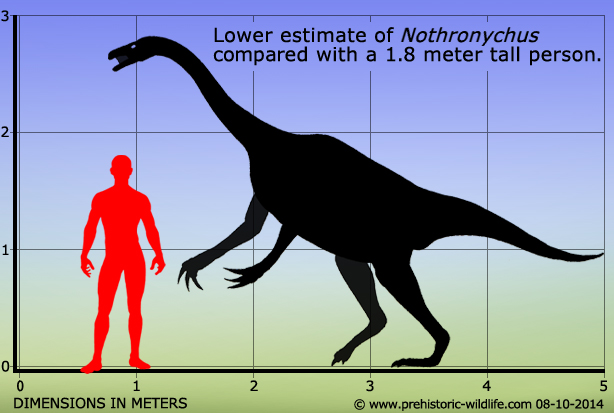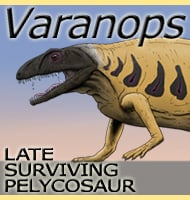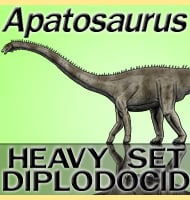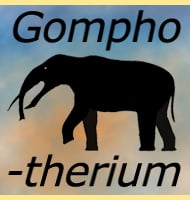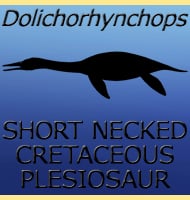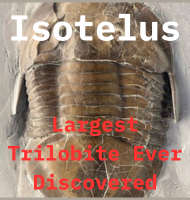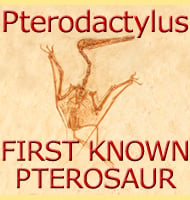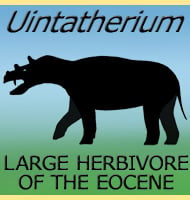In Depth
First described in 2001, Nothronychus was the first genus of therizinosaurid dinosaur to be discovered in North America (the state of New Mexico in the USA), with other earlier notable discoveries such as Beipiaosaurus and Therizinosaurus being discovered in China and Mongolia. However the first fossil of Nothronychus called an ischium (the rear downward projection on the pelvis), was first interpreted as being a squamosal bone of the ceratopsian dinosaur Zuniceratops (squamosals on ceratopsian dinosaurs form the outer edges of the neck frill). More study of both this ischium and the fossil location soon revealed further remains of a then unknown genus of dinosaur, and the remains of this individual would become the holotype specimen of Nothronychus.
Therizinosaurid dinosaurs are noted for having very large claws on the tips of their fingers, and most palaeontologists agree that these claws would have been used to hook around branches to facilitate feeding in a similar manner to how you can see a sloth use its long claws to do just this today. This was the inspiration for the name Nothronychus which roughly means ‘slothful claw’ the type species name N. mckinleyi is in honour of the land owner where the Nothronychus type fossil was found, Bobby McKinley. It was only one year later however that another Nothronychus specimen was found, this time in Utah. This individual would later be named as a second species of Nothronychus named N. graffami in 2009, and in honour the discoverer, M. H. Graffam.
Between these two species, N. mckinleyi seems to have been a little smaller and noticeably less robust in build that N. graffami. Finer details between them include N. mckinleyi having a more pronounced bend in the lower arm, as well as differences in the caudal (tail) vertebrae. Beyond this though, both species of Nothronychus display what has become the classic therizinosaurid body form, of a squat bipedal theropod dinosaur with a large belly, for a much larger digestive system (essential for digesting plant material that takes longer to digest than meat). Actual feeding adaptations include proportionately long necks for reach, and claws on fingers to pull on branches so that an individual can reach taller growths. Nothronychus is known to have leaf shaped teeth which would have been ideal for slicing up soft plants, while there is also speculation that Nothronychus would have also had a keratinous beak.
An interesting side note about Nothronychus graffami is that the type specimen for this species was recovered from a marine deposit. This means that this individual Nothronychus had somehow been swept out to sea and finally come to rest on the bottom of what would then have been known as the Western Interior Seaway, the shallow sea that once submerged central North America from Mexico all the way into Canada, dividing North America into western and eastern landmasses called Laramidia and Appalachia respectively.
Further Reading
- First definitive therizinosaurid (Dinosauria; Theropoda) from North America. - Journal of Vertebrate Paleontology, 21(3): 410-414. - J. I. Kirkland & D. G. Wolfe - 2001. - New records of vertebrates from the Late Cretaceous Tropic Shale of Southern Utah. - Paleontological Research in Grand-Staircase Escalante National Monument and Surrounding Area I. - L. B. Albright III, D. D. Gillette & A. L. Titus - 2002. - Discovery and excavation of a therizinosaurid dinosaur from the Upper Cretaceous Tropic Shale (Early Turnoian), Kane County, Utah. - Paleontological Research in Grand-Staircase Escalante National Monument and Surrounding Area I. - D. D. Gillette, L. B. Albright III, A. L. Titus & M. H. Graffam - 2002. - A new North American therizinosaurid and the role of herbivory in ‘predatory’ dinosaur evolution. - Proceedings of the Royal Society B: Biological Sciences - L. E. Zanno, D. D. Gillette, L. B. Albright & A. L. Titus - 2009. – A re-evaluation of the basicranial soft tissues and pneumaticity of the therizinosaurian Nothronychus mckinleyi (Theropoda; Maniraptora). – PLOS ONE. 13 (7): e0198155. – D. K. Smith, R. K. Sanders & D. G. Wolfe – 2018.
